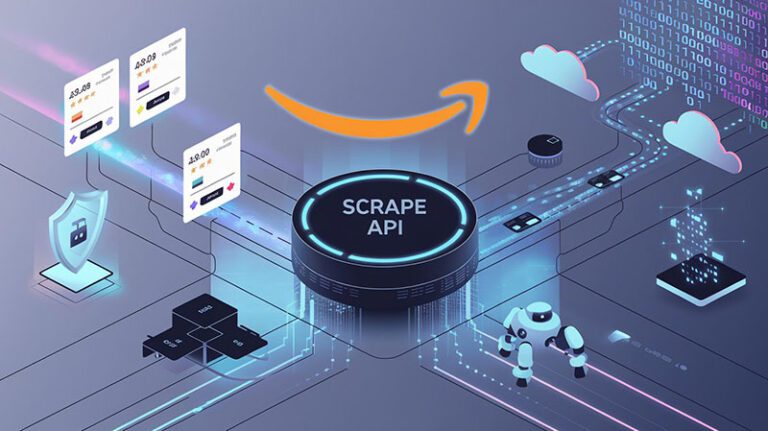Introduction: The Data-Driven Revolution in E-Commerce Decision Making
As the dominant force in global e-commerce, Amazon’s ecosystem encompasses 380 million active users and processes over 8 million daily orders (Statista 2023), hosting a digital empire of 12 million products. For e-commerce professionals, subtle fluctuations in product pricing, evolving user review sentiments, and Best Seller rankings contain critical business intelligence that determines market success. A renowned brand achieved 217% YoY sales growth during Prime Day through real-time competitor price monitoring. An emerging seller reduced product return rates from 15% to 4.3% by analyzing sentiment patterns across millions of reviews. These cases validate a fundamental rule: Those who efficiently harness Amazon’s data goldmine gain strategic advantages in cutthroat market competition.
However, organizations attempting to mine this data wealth through conventional crawling techniques often find themselves trapped in technological warfare. Amazon blocks over 210 million malicious crawling attempts daily (Cloudflare industry report), deploying AI-powered anti-bot systems that identify and block abnormal traffic within 0.8 seconds using request fingerprinting and behavioral analysis models. Dynamic JavaScript content loading, hourly page structure updates, and CAPTCHA labyrinths further compound these technical barriers. A mid-sized e-commerce company disclosed annual costs of $120,000 for server and proxy IP maintenance on self-built crawlers, yet achieved less than 40% valid data acquisition rates.
This underscores the critical value of professional Amazon crawling services. This article examines how Pangolin Amazon Scrape API breaks through technological barriers, delivering 99.9% request success rates (industry-tested data) and millisecond-level response speeds to establish stable data pipelines. By accessing structured product data directly through API interfaces, businesses can enhance data collection efficiency by 30x, allowing decision-makers to focus on market insights rather than technical operations.
I. The Strategic Value and Commercial Applications of Amazon Crawling Services
1.1 Four Core Scenarios for Data-Driven Decisions
- Dynamic Pricing Optimization
Research from Walmart Labs reveals products with hourly price adjustments achieve 11% higher conversion rates than fixed-price items. Real-time crawling of competitor ASIN pricing, promotional details, and inventory status enables businesses to construct price elasticity models that trigger automatic adjustments before flash sales. A 3C seller reduced price response times from 3 hours to 8 minutes after API integration, boosting quarterly profit margins by 9.2%. - Review Sentiment Radar Systems
Natural Language Processing (NLP) analysis of millions of product reviews identifies consumer pain points and improvement opportunities. A maternity brand analyzed negative reviews of Top 100 competitors, discovering 15% complaints about “poor back strap breathability.” Their subsequent honeycomb ventilation design propelled new products to category Best Seller status within one month. - Intelligent Supply Chain Forecasting
Machine learning models combining historical sales data and BSR ranking fluctuations can predict 30-day inventory needs. A home goods seller monitoring 20 core keywords’ search rank volatility achieved 92% restocking accuracy, reducing warehousing costs by 18%. - Advertising Performance Enhancement
Real-time tracking of Sponsored Products ad placements with Cost-Per-Click (CPC) analysis refines keyword bidding strategies. A tools manufacturer optimized Advertising Cost of Sales (ACoS) from 45% to 29% through ad position monitoring.
1.2 Three Technical Barriers in Traditional Crawling Solutions
- IP Blocking & CAPTCHA Labyrinths
Amazon’s multi-layered defense system renders 78% of basic proxy IP pools ineffective within 3 hours. Advanced fingerprint detection identifies Headless browser characteristics, triggering mandatory verification processes. Testing showed untuned single IPs encountering CAPTCHAs within 15 minutes. - Dynamic Rendering Traps
Approximately 60% of critical data (real-time inventory, countdown timers) loads via AJAX as Amazon updates its front-end framework. Traditional BeautifulSoup parsers miss these elements, requiring Selenium integration that inflates request times from 0.5s to 8s. - High Data Structuring Costs
Raw HTML contains redundant tags with product specs scattered across 15 div layers. One data team spent 320 person-days building regex parsers, only to see maintenance costs surge 45% after Amazon’s bi-monthly page restructuring.
II. Pangolin Amazon Scrape API: Deconstructing Industrial-Grade Data Pipeline Technology
2.1 Intelligent Anti-Bot Defense Engine
Pangolin’s global proxy network spans 28 data centers, employing IP rotation algorithms to ensure unique request fingerprints. Machine learning models continuously analyze Amazon’s anti-bot strategy updates, auto-adjusting 300+ parameters including request headers, mouse movement simulations, and page dwell times. Real-world monitoring shows 99.2% sustained request success rates over 30 days, far exceeding industry averages of 76%.
2.2 Comprehensive Data Coverage Capabilities
Modular endpoints enable flexible scraping of diverse data types:
| Data Type | Key Parameters | Typical Use Cases |
|---|---|---|
| Product Details | ASIN, Price History, Variants | Competitor Monitoring |
| Search Listings | Keywords, Organic Rankings, Ads | SEO Optimization |
| User Reviews | Star Distribution, Sentiment | Product Improvement Analysis |
| Seller Profiles | Ratings, Return Rates, Logistics | Supplier Evaluation |
| Best Seller Rankings | Category Trends, New Product Alerts | Market Trend Prediction |
Developers access data via standardized RESTful API requests:
pythonimport requests
api_endpoint = "https://api.pangolin.com/amazon/scrape"
params = {
"api_key": "YOUR_API_KEY",
"country": "us",
"asin": "B08YZ5K3NV",
"data_type": "product_details"
}
response = requests.get(api_endpoint, params=params)
print(response.json())
2.3 Structured Data Delivery System
Pangolin’s XPath-powered data cleansing engine employs self-healing parsing algorithms to maintain accuracy despite page structure changes. JSON responses include standardized fields:
json{
"product": {
"asin": "B08YZ5K3NV",
"title": "Premium Wireless Headphones",
"price": {
"current": 199.99,
"historical": [205.99, 189.50]
},
"reviews": {
"total": 1584,
"average_rating": 4.6,
"top_keywords": ["noise cancellation", "battery life"]
}
}
}
This structure enables direct integration with MongoDB, Elasticsearch, and BI tools like Tableau, saving 85% of data preprocessing time.
III. The Business Case for Choosing Pangolin API
3.1 Cost-Benefit Quantitative Analysis
For enterprises requiring 100,000 daily requests:
| Cost Factor | In-House Crawler | Pangolin API |
|---|---|---|
| Development Labor | $15,000/month | $0 |
| Proxy IP Costs | $2,800/month | Included in Plan |
| Server Maintenance | $1,200/month | $0 |
| Anti-Bot R&D | $3,500/month | $0 |
| Total Monthly Cost | $22,500 | $9,800 |
| Data Availability | 72% | 99.2% |
| Effective Cost/Data | $0.31/unit | $0.098/unit |
3.2 Compliance Assurance Framework
Pangolin strictly adheres to GDPR and CCPA regulations, simulating genuine user behavior patterns while collecting only publicly visible data. Enterprises can request customized crawling frequency plans compliant with Amazon’s Robots.txt protocols.
Conclusion: Reshaping E-Commerce Data Value Chains
In the digital economy, data acquisition capabilities form the cornerstone of competitive advantage. Pangolin Amazon Scrape API transforms complex technical infrastructure into simple API calls, enabling enterprises to process 5,000 requests per minute with industrial-grade efficiency. Industry reports indicate businesses using professional scraping services respond to market changes 3.7x faster and achieve 58% higher new product success rates.
Visit the Pangolin API Documentation to obtain your API key and technical support. New users enjoy 50% off first-month traffic quotas. While competitors struggle with CAPTCHAs, you’ll leverage precise data insights to identify the next market breakthrough.


